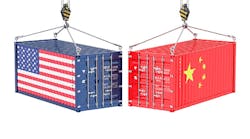Determining the Country of Origin Is Key During the U.S.-China Trade War
Both the United States and China have used tariff increases heavily during the trade war between the two countries, which has led to the disruption of the supply chain. Many businesses have moved out of the U.S. and China to third-party countries, such as Vietnam, to manufacture their products there in an attempt to avoid the tariffs on both sides. But what does it take for a product to be considered as “made in Vietnam” as opposed to “made in China” or “made in the USA”? For example, if the raw materials are imported from China but the product is put together in Vietnam, is the product “made in Vietnam”?
The key to answering to this question is the determination of the country of origin. Because the U.S. Section 232 measures only specific products “originating in China” and the Chinese State Council Tariff Commission TAC [2018] No. 13 and other additional tariff documents only aim at specific products “originating in the United States,” it is extremely important that we carefully examine the country of origin rules in both countries.
What Is the “Country of Origin”?
In the international trade context, the origin of products is also referred to as the “economic nationality” of commodities. Most countries will give different treatment over imported products according to each country’s own interests. The country of origin can affect, among other things, admissibility, the application of preferential tariff rates, eligibility for special programs, marking requirement or the addition of retaliatory tariffs based on anti-dumping, countervailing and other trade protection needs, such as the 15%-25% tariff imposed in the U.S.-China trade war.
In order to implement these tariff differential treatments, quantitative restrictions or other trade-related measures, customs must determine the country of origin of the imported goods in accordance with the rules of the country origin and give appropriate customs treatment. Therefore, the determination of the origin is an important basis and prerequisite for the effective implementation of tariff treatment and trade measures adopted by a country.
Notably, there is no worldwide international agreement on the determination of country of origin and each government applies their own rules. As a general matter, there are two types of rules governing country of origin markings: preferential and nonpreferential. Preferential rules apply as part of a free or preferential bilateral or regional trade agreement governing whether a product can benefit from any special tariff preferential treatment, and nonpreferential rules apply when a product does not qualify for any preferential treatment. The additional tariffs imposed during the U.S.-China trade war refer to nonpreferential treatment, so this article will limit the scope of discussion to nonpreferential country of origin rules only.
What Is the Country of Origin Rule in the U.S.?
Under the Tariff Act of 1930 and corresponding regulations, for goods that are “wholly obtained” (grown, produced or manufactured) in a single country of origin, the country of origin of the goods is that single country. For goods that are manufactured in, assembled in, or use materials originating in more than one country, the country of origin of the goods is the last place in which the good was substantially transformed into a new and distinct article of commerce. A “substantial transformation” is defined generally as working or processing that results in the creation of a new and different article of commerce, having a name, character or use different from those of its components.
Specifically, the U.S. Customs and Border Protection (CBP) considers the following factors in the substantial transformation determination:
1. the character/name/use of the finished article;
2. the nature of the article’s manufacturing process, as compared to the process used to make the component parts or materials used to make the product;
3. the value added by the manufacturing process compared to the value imparted by the component parts or materials;
4. whether the essential character is established by the manufacturing process or by the essential character of the component parts or materials.
The country of origin determination is very fact-specific. The CBP relies on a body of court decisions, CBP regulations and agency interpretations to determine the country of origin of imported products.
Every article of foreign origin (or its container/package) imported into the U.S., unless specifically exempted, must be marked in a manner that will indicate to the ultimate purchaser of the article’s country of origin. The CBP determines the origin of all imported goods and may refuse to release the goods for any improperly marked goods.
What Is the Country of Origin Rule in China?
China’s country of origin rules are mainly governed by the Regulations on the Origin of Import and Export Goods of the People’s Republic of China and the Regulations on Substantial Changes in Nonpreferential Rules of Origin (Order of the General Administration of Customs, No. 122). Those rules are summarized below:
1. Goods are either obtained wholly in one country (region), with the country (region) as the origin, or goods are produced by two or more countries (regions), with the country (region) that finally completed the substantial change as the origin.
2. The criteria for determining substantive changes are based on the tariffs classification as a basic standard, supplemented by the ad valorem percentage, and manufacturing or processing operations. Specifically, goods listed in the List of Goods Applicable to Manufacturing or Processing Procedures and Ad Valorem Percentage Standards (“List”) are subject to specific criteria to determine whether substantial changes have occurred. On the other hand, the tariffs classifications set forth in the Import and Export Tariff of the People’s Republic of China will be applied in determining substantial changes in goods not included in the List.
● The “tariffs change classification” standard refers to the change of the good’s four-digit number in the tariffs classification set forth in the Import and Export Tariff of the People’s Republic of China after the manufacture and processing of the original materials of a country (region) in a certain country (region).
● The “ad valorem percentage” standard refers to the value-added portion of a country (region) that manufactured or processed materials not from that country (region) that exceeds 30% of the value of the goods obtained.
● The “manufacturing and processing process” standard refers to the main process of giving the basic characteristics of goods obtained after manufacturing and processing in a certain country (region).
Under the Chinese rules, the consignee of imported goods shall declare the origin of the goods to China Customs. Customs will review the documents, conduct inspections if necessary, or require the company to provide further relevant materials to determine the origin of the goods.
Application and Takeaway
The CBP and China Customs will determine whether the imported goods originated in the U.S. or China in accordance with the above-mentioned country of origin rules. Until the resolution of the U.S.-China trade war, both the CBP and China Customs will carefully inspect the country of origin of imported goods from other countries to ensure that the increased tariffs will be effectively implemented. Therefore, it is extremely important that importers familiarize themselves with the country of origin rules and consult with their trade advisers to ensure whether a product they intend to manufacture or purchase in a third country are of Chinese origin or of a third country and whether such products would be subject to additional tariffs. It is additionally recommended that when in doubt, importers seek rulings from the CBP or China Customs confirming country of origin prior to any change of supply, manufacturing or shipping importers. Importers should further familiarize themselves with remedial measures available and safeguard their rights and interests in accordance with the law.
Specifically, for products imported to the U.S., should the importer disagree with the CBP’s country of origin determination, it can file a defense and provide corresponding certification materials, such as that the product is simply packaged without any substantial transformation of name, character or purpose of the product in China. The importer may additionally submit for reconsideration to the CBP within 90 days from the CBP’s decision date. The CBP shall make a reconsideration decision within 30 days. The importer can also apply for an extension of the time limit during the reconsideration process to prepare evidence. If the importer is dissatisfied with the final decision of the customs, it may file a lawsuit with the U.S. Court of International Trade within 180 days of CBP’s final decision. If the importer is still dissatisfied with the judgment of the International Trade Court, it can appeal to the U.S. Court of Appeals for the Federal Circuit for final review.
For products imported to China, should the importer disagree with China Customs’ country of origin decision, it can apply for administrative reconsideration within 60 days from the decision date at the next higher level of China Customs. The administrative reconsideration agency shall make an administrative reconsideration decision within 60 days from the date of accepting the application. In special circumstances, it may be extended for 30 days. If the importer still disagrees with the administrative reconsideration decision, it may file an administrative lawsuit with the court within 15 days from the date of receipt of the reconsideration decision.
It is worth noting that any administrative lawsuit is subject to the “reconsideration prerequisite” procedure, meaning that the importer must first file for reconsideration with the China Customs administrative reconsideration agency before it is allowed to file any actions in the court.
Yuanyou “Sunny” Yang is an associate at the law firm of Duane Morris LLP (www.duanemorris.com). She is admitted to practice in the U.S. (Pennsylvania and New York) and the People’s Republic of China. As a Chinese lawyer in the U.S., her practice includes negotiating and structuring business transactions and overseeing the legal operations for Chinese companies doing business in the U.S., as well as assisting U.S. companies in pursuing investment opportunities in China.



